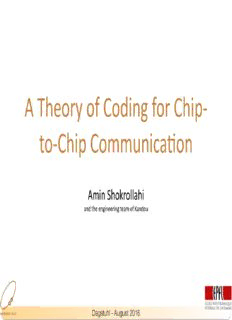
Amin Shokrollahi PDF
Preview Amin Shokrollahi
A Theory of Coding for Chip-‐ to-‐Chip Communica6on Amin Shokrollahi and the engineering team of Kandou Dagstuhl - August 2016 The Problem Dagstuhl - August 2016 Chip-‐to-‐Chip Communica6on 1 2 p p i i h h C C Communica)on wires Dagstuhl - August 2016 Abundant…. Dagstuhl - August 2016 Noise 1 2 p p i i h h C C Noise scales badly with frequency of transmission: Example: -‐40dB at frequency f, -‐90dB at 2f Signal strength Signal strength drops to ~1% drops to ~0.003% Dagstuhl - August 2016 Power Supercomputers Data centers Internal traffic in Giga- 1E+12 4E+11 bits per second Power in Mega-Watts 20000 8000 Mul6ply by 4 in every genera6on (~2 years) Very par6ally offset by Moore’s law Dagstuhl - August 2016 Point in Case “While CPU’s doubled performance every two years, evolu6on from 1 GigE to 10GigE took 12 years, and WAN routers increased throughput only 4-‐fold during the same 6me period.” [6] Andy Bechtolsheim, 2012 Dagstuhl - August 2016 Capacity ) 450 ~20x s p b 400 G ( 350 e r i w 300 r e p 250 t u 200 p h g 150 u o r 100 h T 50 2 4 6 8 10 12 14 16 18 Today Std dev of noise (mV) Dagstuhl - August 2016 Channel is NOT Similar to…. Or any channel with a lot of “random” noise Dagstuhl - August 2016 Noise Deterministic Random SSO Ref Xtlk EMI CM ISI Thermal Almost all noise is determinis6c but resources are 6ght Dagstuhl - August 2016
Description: